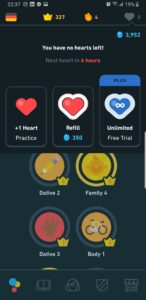
Most mobile apps have two main problematics : (1) how do I keep my users engaged and (2) how do I monetize my app. Concerning the first problematic, Duolingo has relied heavily on daily reminder notifications and streak reminders. The second problematic, on the other hand, seems to be more of a challenge.

Duolingo launched in 2011, funded by grants and venture capitalists. The app went through many business models before arriving to today’s freemium business model. Initially, the idea was to teach the users a new language while they helped translate articles. In this business model, companies needed translation services would pay while the app users would learn for free. When this business model did not gain traction, the company pivoted to an ad-based business model with service extras, such as language certification, streak restore and Gem purchase, as revenue supplements.
Based on these supplemental services and customer feedback, Duolingo’s CEO Luis von Ahn learned that many of its customers would be willing to pay to use the service. To ensure that the service met the original objective of providing language education for free to everyone while also allowing for financial security of the company, von Ahn decided to launch a paid version in 2017. The paid version does not hinder the functionality of the free app and is marketed as a way to fund the free version of the app for those who cannot afford paid language education.
Originally, the paid version removed ads and allowed for streak repairs. Recently, however, Duolingo changed some of the features of the app in order to further those two main problematics.
The Duolingo experience now includes hearts. Every user starts off with five hearts. In order to practice, a user needs to have a heart available. At every mistake, however, one heart is deducted. The hearts replenish themselves every four hours for a maximum of five hearts. Otherwise, the user can buy a heart with Gems (Duolingo’s currency) or they can subscribe to premium where they have unlimited hearts.
Duolingo claims that the reason for this change is that some people are binging the app’s content which does not promote effective language learning. Personally, I believe that this is intended to promote pro subscriptions. Additionally, for those who cannot afford the subscription, it is intended to increase their app usage. The app leverages the same basic human mentality of “I want to do something because I am told that I can’t do it” that apps love to exploit. When you have unlimited access to a resource, you put off using it. When you are told that you cannot practice, you are anxious for your hearts to fill up in order to be able to practice.
Another benefit that this heart system may have is discouraging bots. Many users have complained that they are never able to reach the top of the leaderboard because some user seem to have a superhuman ability of racking up experience. This was possible before since every lesson resulted in ten experience points regardless of performance. Today, that is no longer possible as the bot will likely lose all its hearts, fail the lesson and not collect any experience points.
That being said, not everyone is pleased with this new heart system. What do you think? Did Duolingo introduce this hearts feature to increase use and increase subscriptions or did it introduce this feature to help users learn more efficiently? Or do you think it’s a little of both?

